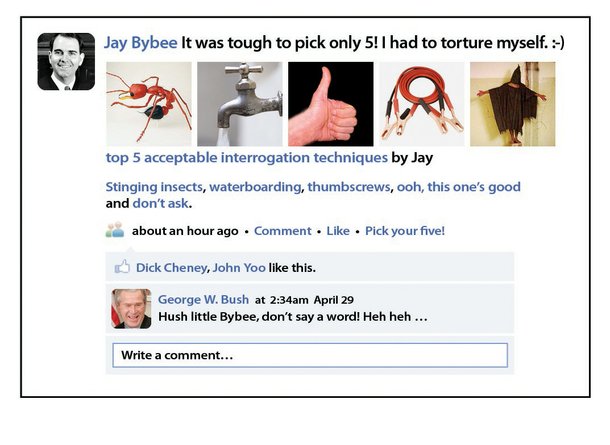There is a line. It’s Section 2340A of the United States Code. It defines torture as: “an act committed by a person acting under the color of law specifically intended to inflict severe physical or mental pain or suffering (other than pain or suffering incidental to lawful sanctions) upon another person within his custody of physical control.”
And there are explorations of the line, investigations of its location and its limits, its strength. The August 2002 memo by Jay Bybee, when he was running the Justice Department’s Office of Legal Counsel, was one such attempt to try to defend the legality of several advanced interrogation techniques the CIA was considering using on suspected terrorists.
More
- Beyond the Weekly
- The definition of torture (Las Vegas Sun, 3/22/09)
- Bybee scrutinized for signing torture memo (Las Vegas Sun, 6/15/09)
Until very recently, Bybee had received a lot less attention than his deputy, John Yoo, as one of the so-called architects of torture under the Bush administration. Following his stint at the Justice Department, Bybee was appointed as a judge in the Ninth Circuit Court of Appeals in 2003. With the Obama administration’s release of several Bush administration memos regarding torture, there’s been a growing call for Bybee’s impeachment.
Bybee has strong Las Vegas ties. He helped found the UNLV School of Law a decade ago, and he is still listed as a senior fellow. His colleagues at the law school are trying to reconcile the memo with the man. Most think Bybee blew it on legal grounds with his memo, but “everyone who knows him thinks he’s a good person,” says Steve Johnson, E.L. Wiegand Professor of Tax Law. Bybee, he says, is “a highly respected scholar, who’s written important journals and law reviews. He’s been a good judge and an outstanding teacher.” Bybee didn’t return a request seeking comment for this story, but Johnson says that his sense of Bybee is that “he and his family have suffered a great deal as a part of the current controversy.”
Bybee wrote the memo to John Rizzo, acting general counsel of the CIA, with regard to the interrogation of al Qaeda operative Abu Zubaydah. Zubaydah was believed to be withholding information regarding terrorist networks in the United States. Intelligence chatter was picking up to pre-9/11 levels. Rizzo wanted to move on to what Bybee quotes as an “increased pressure phase” that could last as long as a month.

The 10 techniques under discussion were: (1) attention grasp, (2) walling, (3) facial hold, (4) facial slap (insult slap), (5) cramped confinement, (6) wall standing, (7) stress positions, (8) sleep deprivation, (9) insects placed in a confinement box and (10) the waterboard.
Words like torture seem clear-cut enough. But the crux of the memo is an attempt to examine whether interrogators intended to inflict severe pain or suffering. And so the decisive word is not torture but “severe.” The memo is an attempt to defend the 10 techniques, both individually and collectively, by claiming they all fall short of severe and are legal.
Some of Bybee’s conclusions:
Example 1: wall standing
“The facial hold and the attention grasp involve no physical pain. In the absence of such pain it is obvious that they cannot be said to inflict severe physical pain or suffering,” Bybee writes. “The stress positions and wall standing both may result in muscle fatigue. Each involves the sustained holding of a position. In wall standing, it will be holding a position in which all of the individual’s body weight is placed on his fingertips. The stress positions will likely include sitting on the floor with legs extended straight out in front and arms raised above the head, and kneeling on the floor and leaning back at a 45-degree angle. Any pain associated with muscle fatigue is not of the intensity sufficient to amount to ‘severe physical pain or suffering’ under the statute. Nor, despite its discomfort, can it be said to be difficult to endure.”
Example 2: facial slap and walling
“The slap is delivered with fingers slightly spread, which you have explained to us is designed to be less painful than a closed-hand slap. The slap is also delivered to the fleshy part of the face, further reducing any risk of physical carnage or serious pain … Likewise, walling involves quickly pulling the person forward and then thrusting him against a flexible false wall.” The idea is that the sound of hitting the wall “will make the impact seem far worse than it is, and that will be far worse than any injury that might result from the action.”
Example 3: confinement boxes
“Similarly, although the confinement boxes (both small and large) are physically uncomfortable because their size restricts movement, they are so small as to require the individual to contort his body to sit (small box) or stand (large box). You have also orally informed us that despite his wound, Zubaydah remains quite flexible, which would substantially reduce any pain associated with being placed in the box.”
Bybee next discusses the ethics of placing an insect in the box with Zubaydah. “As we understand it, no actually harmful insect will be placed in the box ... An individual placed in a box, even an individual with a fear of insects, would not reasonably feel threatened with severe physical pain or suffering if a caterpillar was placed in the box.”
Example 4: the waterboard
Waterboarding, the symbol of Bush-era practices, is a simulation of drowning. “You have informed us that this procedure does not inflict actual physical harm. Thus, although the subject may experience the fear or panic associated with the feeling of drowning, the waterboard does not inflict physical pain. As we explained in the Section 2340A Memorandum, ‘pain and suffering’ as used in Section 2340 is best understood as a single concept, not distinct concepts of ‘pain’ as distinguished from ‘suffering.’ … The waterboard, which inflicts no pain or actual harm whatsoever, does not, in our view, inflict ‘severe pain or suffering.’”
Bybee goes on to say that even if suffering is treated as a distinct concept, the waterboard could not be said to inflict severe suffering: “The waterboard is simply a controlled acute episode, lacking the connotation of a protracted period of time generally given to suffering.”
In assessing his colleague, Johnson notes, “I have to admit I have less confidence in myself. I don’t know if I’d been in his position, under the circumstances that then existed, I don’t know if my interpretation would have been completely detached from those felt necessities.”
But on the other hand, there’s the “perceived moral legitimacy of the country and its government, and that’s a definite cost. I’m not sure we’ve gotten really good information under torture that we couldn’t have gotten through other means. It’s not clear to me any American lives have been saved with torture that would have been lost without it.”








Previous Discussion: